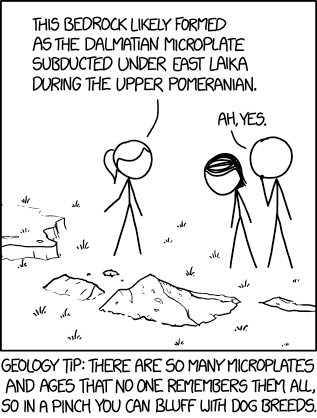1829: Geochronology
| Geochronology |
 Title text: 'The mountains near here formed when the ... Newfoundland ... microplate collided with, uhh ... Labrador.' 'Ok, now you're definitely just naming dogs.' 'Wait, no, that's actually almost correct.' |
Explanation[edit]
This is another one of Randall's Tips, this time a Geology Tip.
Ponytail is describing the origin of some rock formations to Megan and Cueball. She apparently forgot the names of the microplates and the age when the subduction occurred, so she substituties them with names of dog breeds (Dalmatian, Laika and Pomeranian) to seem knowledgeable and impress her audience.
Although no microplates or geological ages with these names exist, this is not obvious for people outside of the field, as dog breeds are often named after geographic regions. For example Dalmatia is the name of a region in Croatia, and a microplate named after it could exist (possibly as a fragment of the former Adriatic Plate). Likewise, a Laika Plate could be named after the Laika Island in Vanuatu; however, the name is unrelated to the island and originates from the Russian word лайка (lit. "barker", a generic name for several breeds of hunting dogs and also the given name of the first dog in space on Sputnik 2). Geological ages are often named after place where the first rocks dating from the age were found e.g. the Devonian is named after the English ceremonial county of Devon (aka Devonshire), while the Permian is named after the Russian city of Perm. Thus, a Pomeranian Age named after Pomerania, a region on the Baltic Sea split between Poland and Germany, might reasonably exist.
So the comic concludes in the caption with one of Randall's many tips, this time a geology tip, about how it is possible to pretend to be more knowledgeable regarding geology (and to bluff others not educated in the science) by just inserting dog breeds names instead of real names as no one remembers the names of all the microplates. An actual geologist, unlike Ponytail, would not be fooled.
The title text continues the situation until Ponytail starts to run out of dog breeds. Her audience catches on... until one of them chimes in that her "explanation" did name two real geological features: the dog breeds Labrador and Newfoundland are named after the two Canadian regions of Labrador and Newfoundland respectively. Geologically, Labrador is the easternmost section of the Canadian Shield, the ancient core of the North American continent. In contrast, Newfoundland (especially western Newfoundland) was formed from terranes, the remnants of a series of plates that collided with - and subducted beneath - North America. Some geologists have assigned the name "Newfoundland Plate" to one of these former microplates that Newfoundland now comprises. However, the title text explanation is not likely to be entirely accurate, because the most significant mountains in Newfoundland are the Long Range Mountains, which are the northernmost of the Appalachian Mountains, created when Africa and North America collided to form Pangaea; no mountain range is identified as being the result of the collision of the Newfoundland Plate with North America.
Subduction was featured in a previous comic 1388: Subduction License. And later mentioned in the title text of 3021: Seismologists.
Transcript[edit]
- [Ponytail is gesturing toward some rock formations in a grass field while addressing Megan and Cueball who are looking down at the rocks, Cueball with a hand to his chin.]
- Ponytail: This bedrock likely formed as the Dalmatian microplate subducted under East Laika during the Upper Pomeranian.
- Cueball: Ah, yes.
- [Caption below the panel:]
- Geology Tip: There are so many microplates and ages that no one remembers them all, so in a pinch you can bluff with dog breeds.
Discussion
Have not edited here before, but the explanation given is missing that Munroe is likely using the strict geological definition of age -- the smallest and most numerous standard division of geologic time, and which frequently varies between regions and are indeed essentially impossible to memorize worldwide, even for specialists. (The examples of the Devonian and Permian given in the current explanation are periods, a division of time that is much longer, of which there are many fewer, and which most geologists would have memorized.) This global timescale from the International Commission on Stratigraphy lists the global standard ages on the far right of each column: http://www.stratigraphy.org/ICSchart/ChronostratChart2016-12.jpg This chart, also from the ICS, lists different national conventions of ages in the Ordovician period alone, and gives a good sense of the kinds of names used: http://www.stratigraphy.org/upload/OrdChartHigh.jpg A couple of dog breeds in there would probably not be noticed. Again, haven't edited here before, unsure if I should just go ahead and edit, or wait for discussion. 108.162.246.227 21:17, 26 April 2017 (UTC)
This might help explaining: https://en.wikipedia.org/wiki/List_of_tectonic_plates Between the Newfoundland Plate (Canada) and the Labrador part of the Canadian Shield the Appalachian Mountains exist.--141.101.105.150 07:45, 26 April 2017 (UTC)
This link is probably more useful: https://en.wikipedia.org/wiki/Geography_of_Newfoundland_and_Labrador I'll leave the detailed explanation to somebody with actual geologic knowledge of the region Condor70 (talk) 09:25, 26 April 2017 (UTC)
- Did what I could, including why the title text isn't actually correct. I'm new to writing these, so feel free to adjust link density or general verbiage if I didn't match local conventions for them! Squeamish Ossifrage (talk) 16:43, 26 April 2017 (UTC)
Dalmatia is a place, but apparently doesn't have a microplate. It might be part of the joke since it makes the first listed microplate somewhat believable.
"Laika" may be an island in Vanuatu (thanks, Wikipedia) but it's not a breed, it's only possibly The Most Famous Dog Ever Ever Ever. --141.101.107.18 11:58, 26 April 2017 (UTC)
- Apparently it's also a breed https://en.wikipedia.org/wiki/Laika_(dog_breed) 162.158.79.5 20:27, 28 April 2017 (UTC)
 Add comment
Add comment
